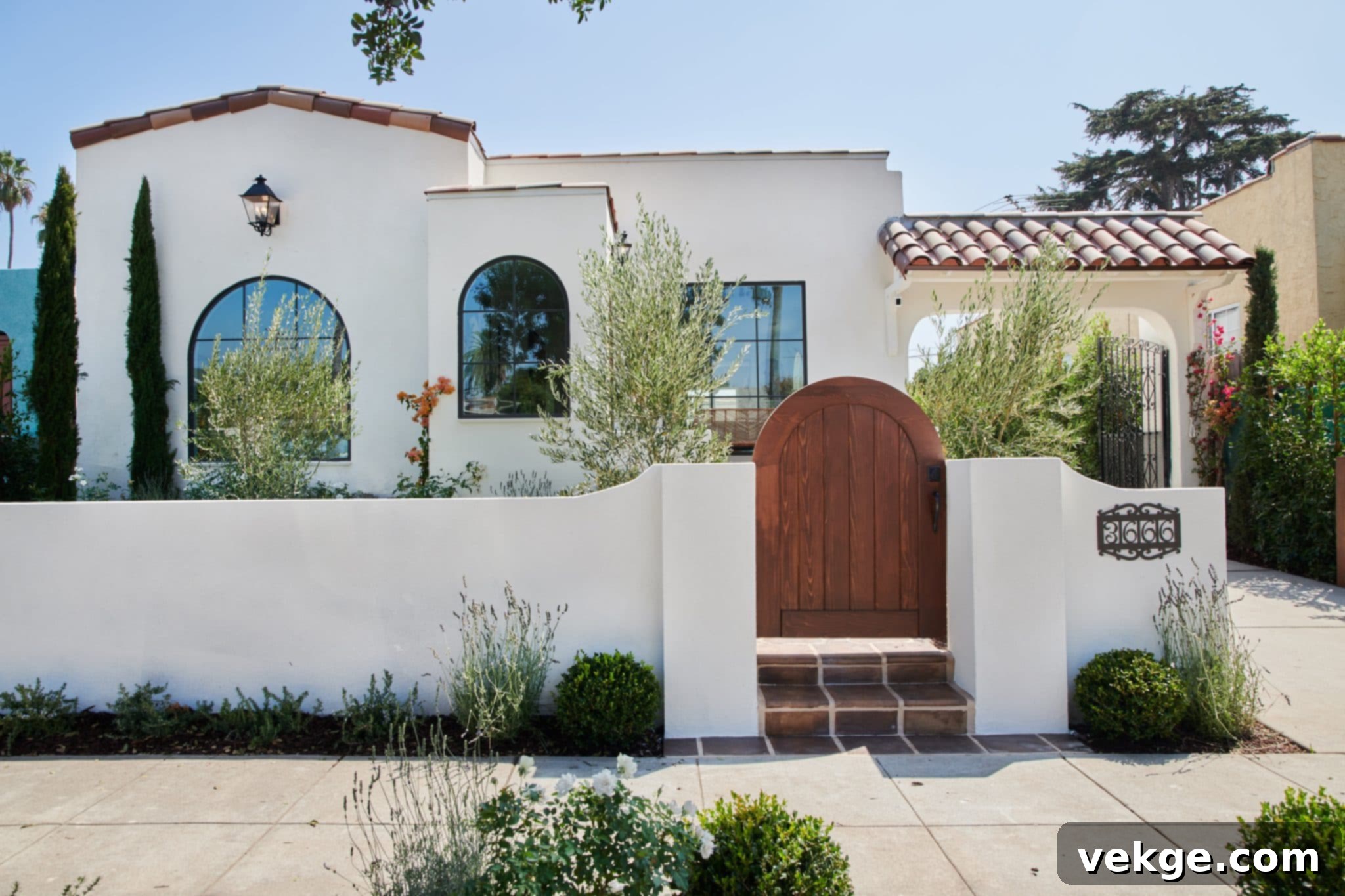Unveiling the Timeless Charm of Spanish-Style Homes: History, Design, and Enduring Appeal
Spanish-style homes, often recognized by their inviting charm and distinctive architectural elements, boast a rich and captivating history spanning centuries. These unique residences, also known as Spanish Revival or Mediterranean Revival, draw deep inspiration from the diverse architectural traditions of Spain and the broader Mediterranean region. They represent a harmonious blend of form and function, offering a romantic and elegant aesthetic that has captivated homeowners for generations. This article will delve into the fascinating story behind Spanish-style designs, exploring their origins, key characteristics, and why they continue to be a beloved choice for those seeking a home with character and warmth.
The journey of Spanish-style architecture in the United States notably began in the early 20th century. During this era, there was a burgeoning fascination with Spanish culture, art, and design, particularly in regions with warm, sunny climates similar to the Mediterranean. This cultural appreciation paved the way for the widespread adoption and adaptation of Spanish architectural motifs, leading to the rise of these beautiful and functional homes. We will trace the evolution of these designs, understanding how various architectural movements influenced them and how they have gracefully adapted over time.
So, let’s explore the defining features that set Spanish-style homes apart and contribute to their unique and lasting appeal.
What Defines a Spanish-Style Home?
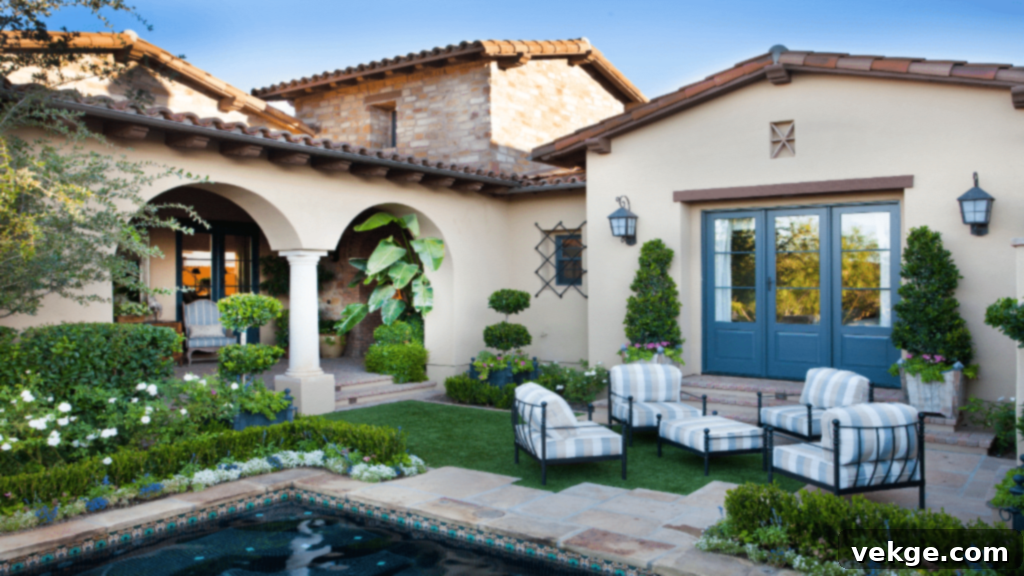
Spanish-style homes, often interchangeably referred to as Spanish Revival or Mediterranean Revival homes, are characterized by a distinct architectural vocabulary known for its classic and inviting appeal. These residences draw heavily from the rich building traditions of Spain, particularly those found in its Mediterranean regions, becoming a celebrated part of American architectural history. Their design is immediately recognizable by signature elements such as smooth stucco walls, iconic red-tiled roofs, and intricate wrought-iron details, all of which contribute to their warm and inviting appearance. Beyond these, Spanish-style homes frequently feature gracefully curved doorways and archways, vibrantly decorative tiles, and serene courtyard gardens, fostering an atmosphere of peace and old-world charm. These elements are not just decorative; they are deeply rooted in practical considerations for warm climates, offering coolness and comfort while exuding timeless elegance.
The Rich Origins of Spanish Home Design in America
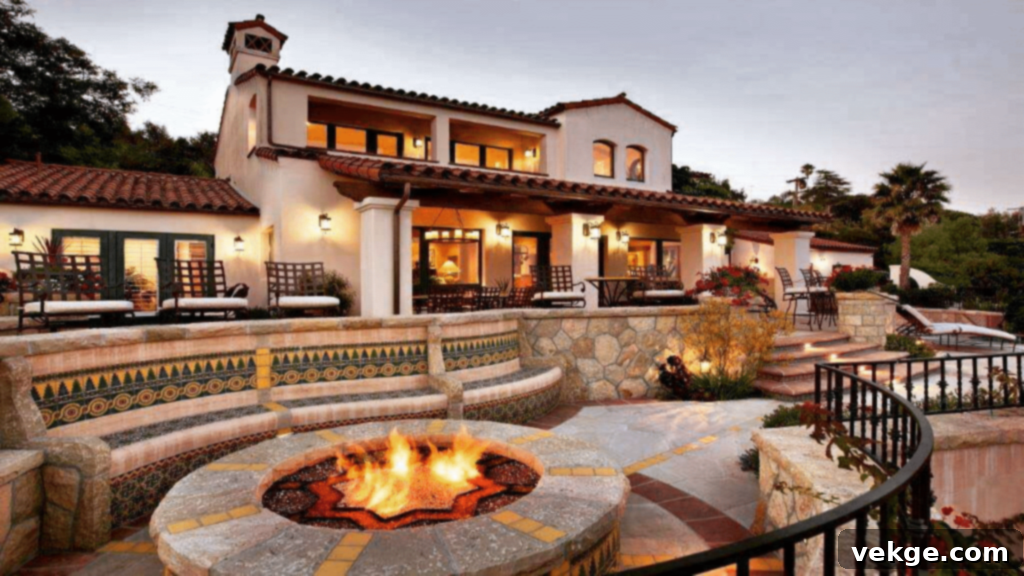
The distinct design of Spanish-style homes in the United States truly began to flourish in the early 20th century. American architects and builders, seeking a style that suited the sunny climates of California, Florida, and the Southwest, drew profound inspiration from the beautiful and functional architecture of Spain. This inspiration was particularly influenced by the architectural traditions of Andalusia, a region in southern Spain known for its rich Moorish heritage, evident in intricate patterns, courtyards, and tilework.
A pivotal moment for this architectural movement was the 1915 Panama-California Exposition in San Diego. The exposition showcased numerous buildings designed in the Spanish Colonial Revival style, captivating visitors and critics alike and igniting widespread interest in the aesthetic. This exposure propelled the style into national prominence.
The broader Spanish Colonial Revival movement, which emerged in the late 19th century, played a crucial role in shaping the specific features we recognize in Spanish-style homes today. Influential architects such as Bertram Goodhue and George Washington Smith were instrumental in popularizing this style. They skillfully integrated elements from historic Spanish missions, grand haciendas, and the intricate, exotic beauty of Moorish architecture into their contemporary designs. This fusion created a unique architectural language that resonated deeply with the American landscape and cultural imagination, blending historical authenticity with modern living.
Understanding Spanish-Style Home Construction
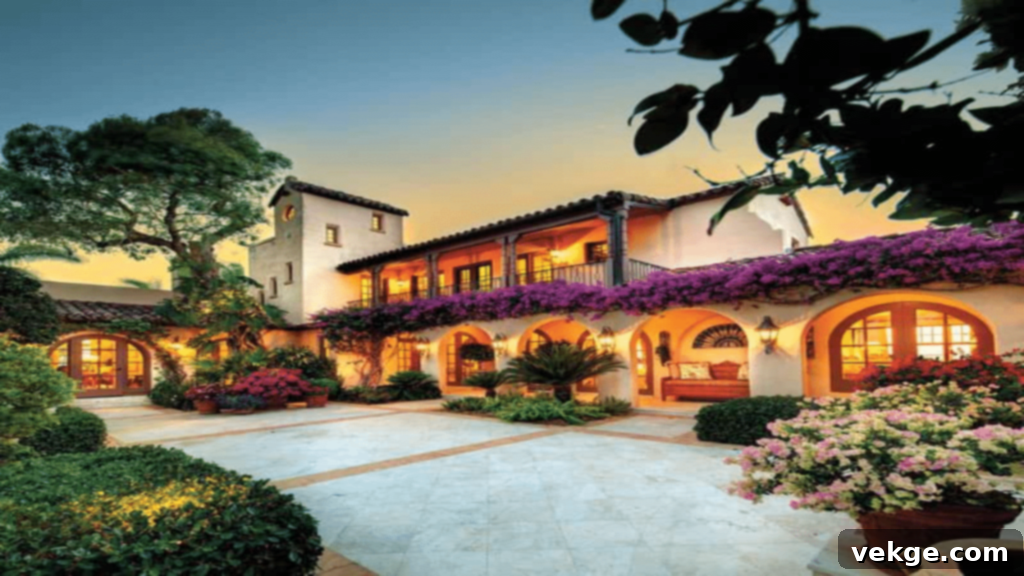
The construction of Spanish-style homes is characterized by specific materials and techniques designed to capture the authentic essence of Spanish architecture while offering practical benefits, particularly in warmer climates. A primary feature is the extensive use of stucco, a durable exterior finish made from a blend of cement, sand, and lime. Applied to the exterior walls, stucco provides a textured, earthy look that is both aesthetically pleasing and highly functional. It serves as an excellent insulator, helping to keep interiors cool in hot weather and warm in cooler seasons, while also offering robust protection against the elements.
Another defining structural and aesthetic component is the red-tiled roof. These roofs are typically made from durable clay tiles, often in a half-barrel or “S” shape, which contribute significantly to the homes’ iconic and picturesque appearance. Beyond their visual appeal, clay tiles are renowned for their longevity, fire resistance, and ability to reflect sunlight, further aiding in thermal regulation. The gentle slope of these roofs also efficiently sheds rainwater. In addition to these primary elements, Spanish-style construction often incorporates exposed wooden beams, both structural and decorative, and ornate wrought-iron elements for railings, grilles, and light fixtures, enhancing the architectural richness and historical feel of these beautiful residences.
Key Architectural Elements That Distinguish a Spanish-Style Home
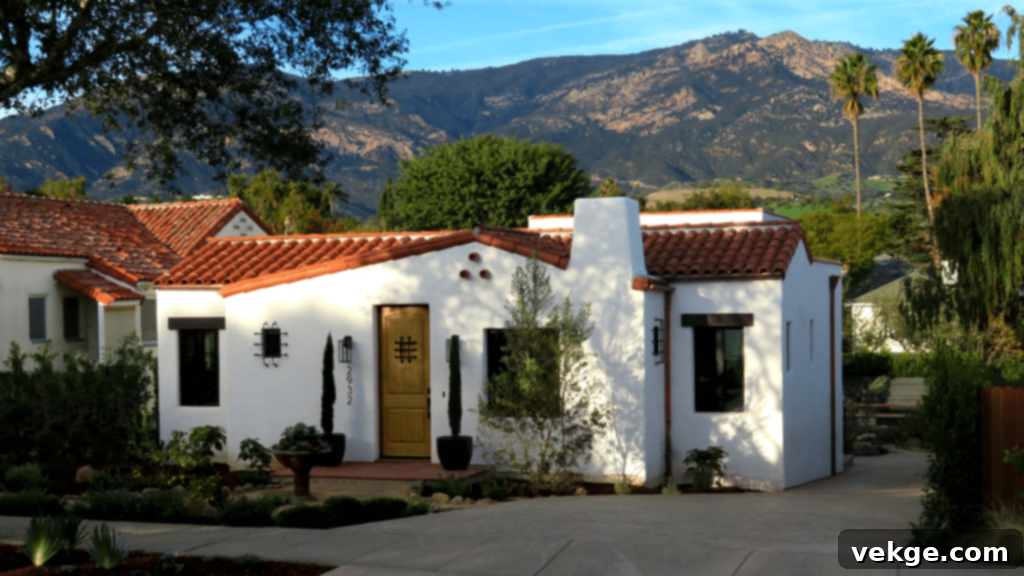
Spanish-style homes are celebrated for their distinctive architectural characteristics, which transport you to the sun-drenched landscapes of the Mediterranean. Let’s explore the essential elements that define these captivating residences, each contributing to their unique charm and functionality.
1. Terracotta or Red Clay Tile Roofs
One of the most instantly recognizable features of Spanish-style homes is their signature terracotta or red clay-tiled roofs. These robust, curved tiles are not merely decorative; they are incredibly durable and provide a warm, earthy hue that beautifully complements the natural surroundings. Beyond their aesthetic appeal, these terracotta tiles play a crucial role in the home’s thermal performance, helping to reflect sunlight and keep the interior cool during hot Mediterranean-like climates. Their layered structure also offers excellent weather protection and contributes significantly to the home’s authentic, old-world character.
2. Elegant Use of Arches
Arches are a fundamental and highly symbolic design element in Spanish-style houses. You’ll find them gracefully curving over doorways, windows, and passageways, both on the exterior and interior. These curved openings add a sense of grandeur and fluid movement, creating seamless transitions between different spaces and connecting the indoors with the outdoors. Structurally sound and visually appealing, arches evoke a romantic and welcoming ambiance, softening the lines of the home and adding an element of historical elegance.
3. Inviting Pastel Exterior Colors
Spanish-style homes frequently showcase an attractive palette of gentle and welcoming pastel colors on their exterior surfaces. These hues typically include creamy whites, soft yellows, warm terracottas, muted pinks, and calming blues or greens. These colors are chosen not only for their aesthetic beauty but also for their ability to reflect sunlight, helping to keep the home cooler. They evoke the bright, sun-drenched scenery of the Mediterranean, contributing to a peaceful and serene feeling that is characteristic of the style.
4. Textured Exterior Stucco Walls
Stucco is an indispensable characteristic of Spanish-style houses. This special coating for the exterior walls, made by mixing cement, sand, and lime, is applied to create a distinct, textured finish. The stucco surface is not just visually interesting; it’s also highly functional, offering excellent insulation properties that help maintain a comfortable interior temperature year-round. It can be left in its natural, earthy tone or painted with the soft, Mediterranean-inspired pastel colors, further enhancing the home’s delightful and authentic appearance. The texture adds depth and character, giving the walls a handcrafted feel.
5. Private Courtyards
Courtyards are integral to Spanish-style houses, significantly enhancing both their beauty and functionality. These secluded outdoor spaces are typically enclosed by the home’s walls, creating a private oasis. Courtyards are often adorned with vibrant decorative tiles, lush green plants, and frequently feature a central fountain, providing soothing sounds and a focal point. They offer a tranquil sanctuary perfect for relaxation, intimate gatherings, and al fresco dining. The presence of a courtyard blurs the lines between indoor and outdoor living, embodying the true spirit of Mediterranean architecture and fostering a connection with nature.
6. Ornate Wrought Iron Details
Wrought ironwork is a hallmark of Spanish-style architecture, adding an element of intricate beauty and craftsmanship. You’ll often find it in decorative grilles covering windows, elegant railings for balconies and staircases, ornate gates, and stylish light fixtures. These handcrafted iron elements provide a striking contrast against the smooth stucco walls and soft pastel colors, introducing a touch of sophisticated artistry and historical authenticity. Beyond their decorative function, wrought iron details also offer security and a sense of timeless elegance.
7. Decorative Tilework (Azulejos)
Inspired by Moorish and Spanish traditions, decorative tiles, often referred to as “azulejos,” play a significant role in Spanish-style homes. These vibrant, hand-painted ceramic tiles are used to adorn stair risers, fountain surrounds, kitchen backsplashes, bathroom walls, and even outdoor patios. Featuring intricate geometric patterns, floral motifs, and rich colors, these tiles add bursts of artistic expression and cultural heritage. They are durable, easy to clean, and contribute immensely to the cheerful and authentic atmosphere of a Spanish-style home.
Could a Spanish Home Plan Be Perfect for You?

Spanish-style homes present an excellent option for individuals who appreciate classic, enduring architecture and desire a warm, welcoming, and culturally rich living environment. They are particularly well-suited for regions with pleasant, warm climates, as their designs inherently promote indoor-outdoor living and provide natural cooling. If you are seeking a home that offers distinctive character, historical depth, and a strong connection to nature and communal spaces through elements like courtyards and large windows, then a Spanish-style home plan might be the perfect fit for you. These homes exude a historic and stylish vibe that many find incredibly attractive, offering not just a dwelling but a lifestyle. Furthermore, if you are considering moving into a Spanish-style home, it’s wise to research reviews of various movers or vehicle shipping companies (like this one) to accurately understand your complete budget and ensure a smooth transition into your beautiful new residence.
Conclusion: The Enduring Legacy of Spanish-Style Homes
Spanish-style homes carry a delightful and profound history that stretches back centuries. Their origins can be traced to Spain in the 16th century, where they began to integrate diverse design ideas from various cultures, including the sophisticated architectural techniques of the Moors and the classical influences of the Romans. This fusion of styles was expertly adapted to cope with the demands of the Mediterranean climate, leading to innovations in materials and layout that prioritized comfort and aesthetic beauty.
As Spanish settlers journeyed to the Americas, they brought these rich architectural traditions with them, planting the seeds for what would become known as Spanish Colonial architecture in the New World. This migration led to the widespread popularity of Spanish-style homes, particularly in sun-drenched regions such as California, Florida, and the Southwestern United States. Here, these homes adapted further, incorporating local materials and cultural nuances, which resulted in unique regional variations while retaining their core Spanish identity.
The history of Spanish-style homes is a vibrant narrative of cultural exchange, climate adaptation, and enduring beauty. From their functional design choices to their captivating aesthetic details, these homes remain a cherished part of architectural heritage, continuing to inspire and provide charming, comfortable living spaces that tell a story of their rich past.
